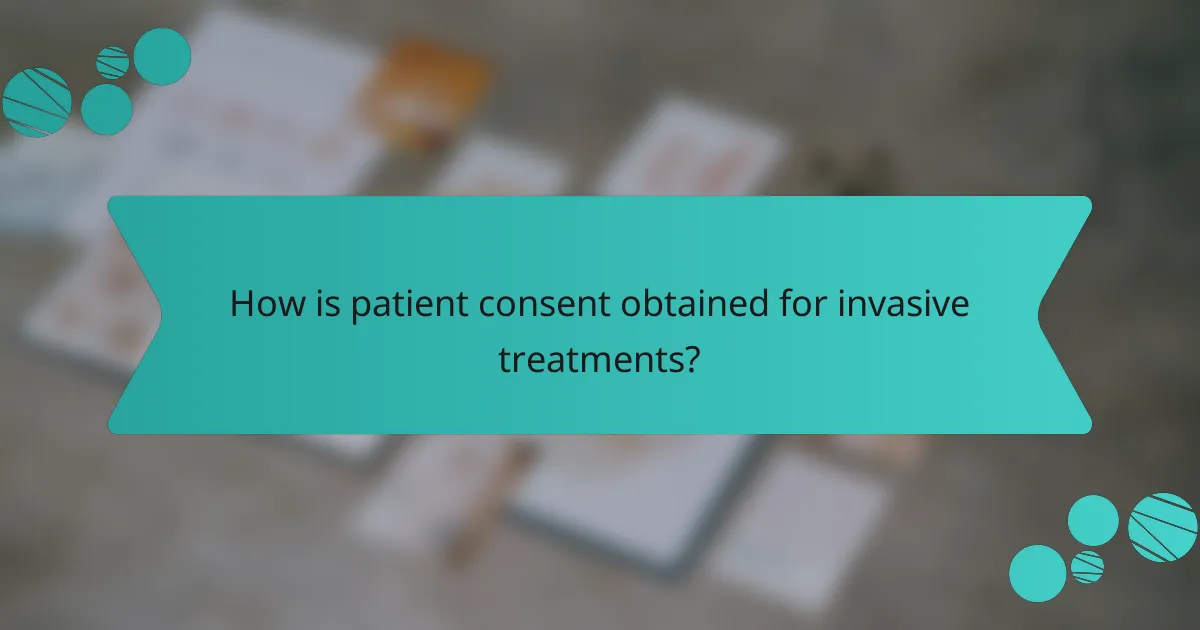Invasive treatments often come with surgical risks that can lead to complications during or after the procedure, making it vital for patients to understand these risks before consenting. Recovery times can vary widely, with minor surgeries requiring only a few days, while major procedures may necessitate weeks or even months for complete healing. The process of obtaining patient consent is essential, ensuring that individuals are fully informed about the procedure, its risks, and available alternatives, thereby upholding their autonomy and legal rights.

What are the surgical risks of invasive treatments?
Surgical risks associated with invasive treatments can include various complications that may arise during or after the procedure. Understanding these risks is essential for informed patient consent and for preparing for recovery.
Infection
Infection is a common risk following invasive treatments, occurring when bacteria enter the body through surgical incisions. Symptoms may include redness, swelling, and fever, which can develop days after surgery.
To minimize infection risk, surgeons typically prescribe antibiotics and recommend proper wound care. Patients should monitor their incisions for any signs of infection and report concerns to their healthcare provider promptly.
Bleeding
Bleeding can occur during or after surgery, potentially leading to significant complications if not managed properly. This may involve minor oozing or more severe hemorrhaging that requires additional medical intervention.
Surgeons assess bleeding risks based on the procedure type and the patient’s health history. Patients should follow pre-operative instructions, such as avoiding blood thinners, to reduce the likelihood of excessive bleeding.
Anesthesia complications
Anesthesia complications can arise during surgery, affecting a patient’s breathing, heart rate, or blood pressure. While rare, these issues can lead to serious consequences if not addressed quickly.
Before surgery, patients should discuss their medical history and any previous reactions to anesthesia with their anesthesiologist. Monitoring during the procedure helps ensure any complications are managed effectively.
Organ damage
Organ damage is a potential risk in invasive surgeries, particularly if the procedure involves delicate areas. Accidental injury to surrounding organs can lead to long-term complications or require additional surgeries.
Surgeons take precautions to avoid organ damage, including using imaging techniques and careful dissection. Patients should be aware of this risk and discuss it with their healthcare provider before surgery.
Blood clots
Blood clots can form after surgery, especially in the legs, leading to deep vein thrombosis (DVT) or pulmonary embolism (PE). These conditions can be life-threatening if clots travel to the lungs or heart.
To reduce the risk of blood clots, patients are often advised to move as soon as possible after surgery and may be prescribed blood thinners. Compression stockings may also be recommended to promote circulation during recovery.

What is the typical recovery time for invasive surgeries?
The recovery time for invasive surgeries varies significantly based on the type of procedure performed. Generally, minor surgeries may require a few days for recovery, while major surgeries can take several weeks or even months for full recuperation.
Days for minor surgeries
Minor surgeries, such as laparoscopic procedures or small excisions, typically have a recovery time ranging from a few days to a week. Patients often experience minimal discomfort and can usually return to normal activities quickly, often within 3 to 7 days.
Common examples include gallbladder removal or hernia repairs. Patients should follow post-operative care instructions to ensure a smooth recovery, including rest and gradual resumption of activities.
Weeks for major surgeries
Major surgeries, like open-heart surgery or joint replacements, generally require a recovery period of several weeks. Patients may need anywhere from 4 to 12 weeks to heal adequately, depending on the complexity of the procedure and individual health factors.
During this time, rehabilitation may be necessary to regain strength and mobility. It’s essential for patients to adhere to follow-up appointments and physical therapy recommendations to optimize recovery.
Factors affecting recovery
Several factors can influence recovery time after invasive surgeries, including the patient’s age, overall health, and the presence of any underlying medical conditions. For instance, younger patients and those in good health often recover faster than older adults or individuals with chronic illnesses.
Additionally, the type of surgery and the surgical technique used can impact recovery. Minimally invasive techniques typically result in shorter recovery times compared to traditional open surgeries. Patients should discuss their specific circumstances with their healthcare provider to understand what to expect during recovery.

How is patient consent obtained for invasive treatments?
Patient consent for invasive treatments is obtained through a structured process that ensures patients understand the procedure, its risks, and alternatives. This process is crucial for respecting patient autonomy and legal requirements.
Informed consent process
The informed consent process involves several steps, starting with a detailed discussion between the healthcare provider and the patient. The provider explains the nature of the treatment, potential risks, benefits, and alternatives, allowing the patient to ask questions.
Once the patient understands the information, they are asked to sign a consent form. This form serves as a legal document indicating that the patient agrees to proceed with the treatment after being adequately informed.
Legal requirements in Canada
In Canada, obtaining informed consent is a legal requirement for invasive treatments. Healthcare providers must ensure that consent is voluntary, informed, and given by a competent individual.
Specific regulations may vary by province, but generally, consent must be documented, and patients have the right to withdraw consent at any time before the procedure. Failure to obtain proper consent can lead to legal repercussions for healthcare providers.
Patient education importance
Patient education is vital in the consent process, as it empowers patients to make informed decisions about their healthcare. Providing clear, accessible information helps patients understand the implications of their choices.
Effective education can reduce anxiety and improve satisfaction with the treatment process. Healthcare providers should use various methods, such as brochures, videos, or one-on-one discussions, to cater to different learning preferences and ensure comprehension.

What are the prerequisites for undergoing invasive treatments?
Before undergoing invasive treatments, patients must meet specific medical and procedural prerequisites to ensure safety and effectiveness. These include thorough medical evaluations and pre-surgery consultations to assess risks and prepare for recovery.
Medical evaluations
Medical evaluations are essential to determine a patient’s overall health and suitability for invasive procedures. These evaluations typically involve physical examinations, medical history reviews, and diagnostic tests such as blood work or imaging studies.
Patients should be prepared to discuss any pre-existing conditions, medications, and allergies with their healthcare provider. This information helps identify potential complications and tailor the treatment plan to the individual’s needs.
Pre-surgery consultations
Pre-surgery consultations provide an opportunity for patients to discuss the procedure in detail with their surgical team. During these consultations, patients can ask questions about the surgery, recovery expectations, and potential risks involved.
It is crucial for patients to understand the informed consent process, which requires them to acknowledge the risks and benefits of the treatment. This ensures that patients make well-informed decisions regarding their health and treatment options.

What are the long-term effects of invasive treatments?
Invasive treatments can lead to various long-term effects, including chronic pain and scarring. These outcomes can significantly impact a patient’s quality of life and should be carefully considered before undergoing any procedure.
Chronic pain
Chronic pain is a common long-term effect of invasive treatments, often resulting from nerve damage, inflammation, or scar tissue formation. Patients may experience persistent discomfort that lasts for months or even years after the procedure.
Management of chronic pain typically involves a combination of medications, physical therapy, and lifestyle adjustments. It is crucial for patients to discuss potential pain management strategies with their healthcare provider prior to surgery.
Scarring
Scarring is another potential long-term effect of invasive treatments, which can vary in severity based on the type of procedure and individual healing processes. Scars may be raised, flat, or discolored, and can affect both physical appearance and mobility.
To minimize scarring, patients should follow post-operative care instructions closely, including keeping the area clean and moisturized. In some cases, treatments such as silicone sheets or laser therapy may be recommended to improve the appearance of scars.
